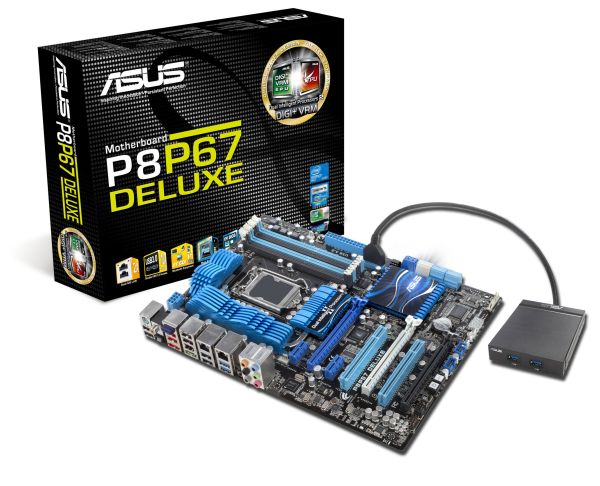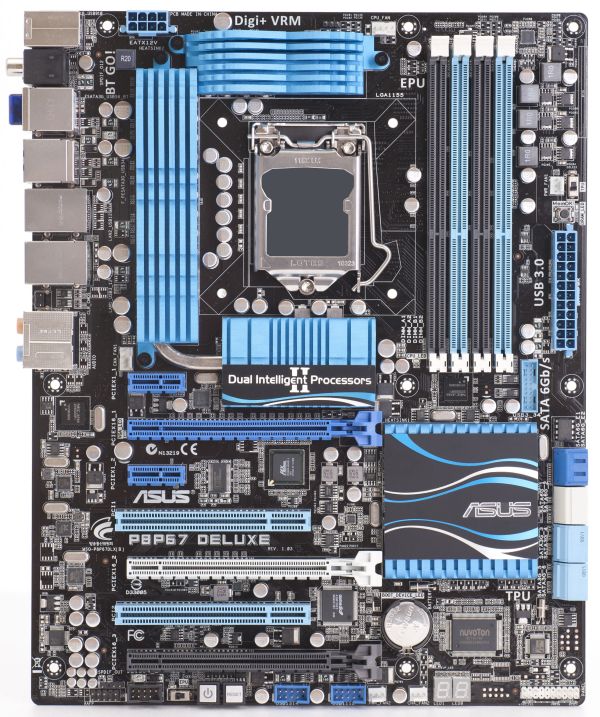A brief look at upcoming ASUS P67 Motherboards
by Ian Cutress on November 14, 2010 1:22 PM EST- Posted in
- News
- Motherboards
- Asus
The Deluxe has more of the features we expected from the Pro board. In a similar design, we see power and reset switches on the board, dual gigabit Ethernet and double-digit debugging LEDs.
The extended VRM heatsink cooling is the most obvious visual change over the Pro, despite the fact that the Pro and the Deluxe both have only one 8-pin 12V connector, which suggests that ASUS have shelled out a few more reddies on the VRM for the socket on the Deluxe. Whether that plays out to any performance gain, or a raise in the performance ceiling, we’ll find out in due course.
The main back panel change, apart from the presence of dual gigabit Ethernet, is the combination PS/2 mouse and keyboard port, and the CMOS clear button. The button itself is recessed slightly behind the 5.1 audio and the USB ports on either side, so in order to press it, you really have to be searching for it. Or if your cat decides it’s a toy on the back panel and accidentally claws it with some force.
Other additions/changes of note is the PLX chip between the first PCIex16 slot and the first PCI slot, and the relocation of the bridging USB2.0/3.0 to SATA ASMedia chip to a more central location next to the battery. The Deluxe, like the Pro, has eight SATA ports in total, but these are labelled, and shows four SATA 3Gb/s (labelled 3, 4, 5 and 6), two SATA 6Gb/s, and two more SATA 6Gb/s, designated ‘E’. This raises a couple of questions – what happened to SATA 3Gb/s which are labelled 1 and 2? If the 6Gb/s ‘E’ designation is for eSATA, why are the back-panel eSATA ports labelled 3Gb/s?
Obviously, expect the Deluxe to retail at a high price than the Pro. How much more, we don’t know yet, and ASUS is keeping that info to themselves.













53 Comments
View All Comments
Egowhip69 - Sunday, November 14, 2010 - link
Not really niche... More for professionals. Many medium and small shops use home made systems for workstations for money reasons. I work at a large Post house, and even we do that when money is tight and we can't afford the mainstream workstations (as they command a VERY large price premium).In our shop, most of our systems are SAN attached through fiber. CVFS (the filesystem we use) requires a secondary nic for "metadata". You can do everything through 1 nic, but at a huge preformance penalty if any latency exists.
Plus, with dual nics, you can setup you system as a router, DHCP server, firewall, print server, dual home the system in a work network, etc.
While I do agree, for 99% of the "high end" gamers won't need it... but for the $.30 it cost to throw the second nic on there... why not? Then your product applies to a larger portion of the users out there.
Taft12 - Monday, November 15, 2010 - link
The Realtek network chip these OEMs use is not at all fit for use in a professional environment.Now please pass me my Intel PCI-E NIC:
http://www.intel.com/products/server/adapters/pro1...
7amood - Sunday, November 14, 2010 - link
Would love to see ASUS get seriously into smaller mobos (mini-ITX).I am planning to use the SilverStone SG07 to build a small beast.
ONLY if ASUS put serious thought into building a good Mini-ITX mobo.
I am already planning two bios settings for it, quite mode where not even the behemoth fan of the SG07 is needed and the other for serious computation and gaming.
Qapa - Sunday, November 14, 2010 - link
The PC could live a lot longer if it moved to SFF, but mostly companies are taking 2 routes:1 - laptops
2 - PCs with the same old size from dozens of years!!
I wish they would focus on SFF as well, I'd make one for myself if it wasn't too damn hard to find the MBs, graphics, etc and at a similar price!
Egowhip69 - Sunday, November 14, 2010 - link
I agree, I love the smaller boards... but the reason the Mobo Manus concentrate on those two areas, is a simple answer... money.To shrink the board, you have to do alot more design and research. This ups the cost, so you have to charge more to recoup. And I don't think they sell even close to as many of the mini and pico boards as normal size ATX, probably cause they cost more.
Laptops are the hot item now. More sales means more money, which means more money going back into R&D into that area, which then makes the product better, which helps drive more sales. All a circle.
Boils down to money. I would like more small options, but until livingroom integration really takes off, I think it'll stay as a smaller niche market.
Mr Perfect - Monday, November 15, 2010 - link
I was going to ask the same thing, where are the mITX boards? Asus made a nice one for AM3s, so we know they're watching the market.Etern205 - Sunday, November 14, 2010 - link
The P8P67 Deluxe has UEFI bioshttp://www.techspot.com/news/40984-asus-motherboar...
After 3:00, look at the top left corner and you'll see the model.
May need to watch it on YouTube to get a clearer picture.
Pneumothorax - Sunday, November 14, 2010 - link
Since Intel's forcing you to by a chip with built in gfx, wouldn't be helpful for at least diagnostic purposes or even a "bad flash" to be able to boot up using the GMA core on Sandy Bridge?Stahn Aileron - Monday, November 15, 2010 - link
It's a P-series chipset. An H6x-series is probably where the intregrated GPU will be supported, much like how the current chipset work (P5x = Dedicated GPUs ONLY; H5x-series for CPUs with integrated GPU.)The question I have to ask is will ALL SB-based chips have a GPU in them, or will the higher-end (like the EE) chips use all the silicon for CPU cores? (I mean, if you're shelling out for a high-end CPU, you probaly have a high-end discrete GPU or a SLI/CrossFire set-up of some sort.)
nevcairiel - Monday, November 15, 2010 - link
All SB chips coming in the first generation (1155 chipset) will have the GPU cores. The 8-cores coming Q3/11 presumably won't have them.